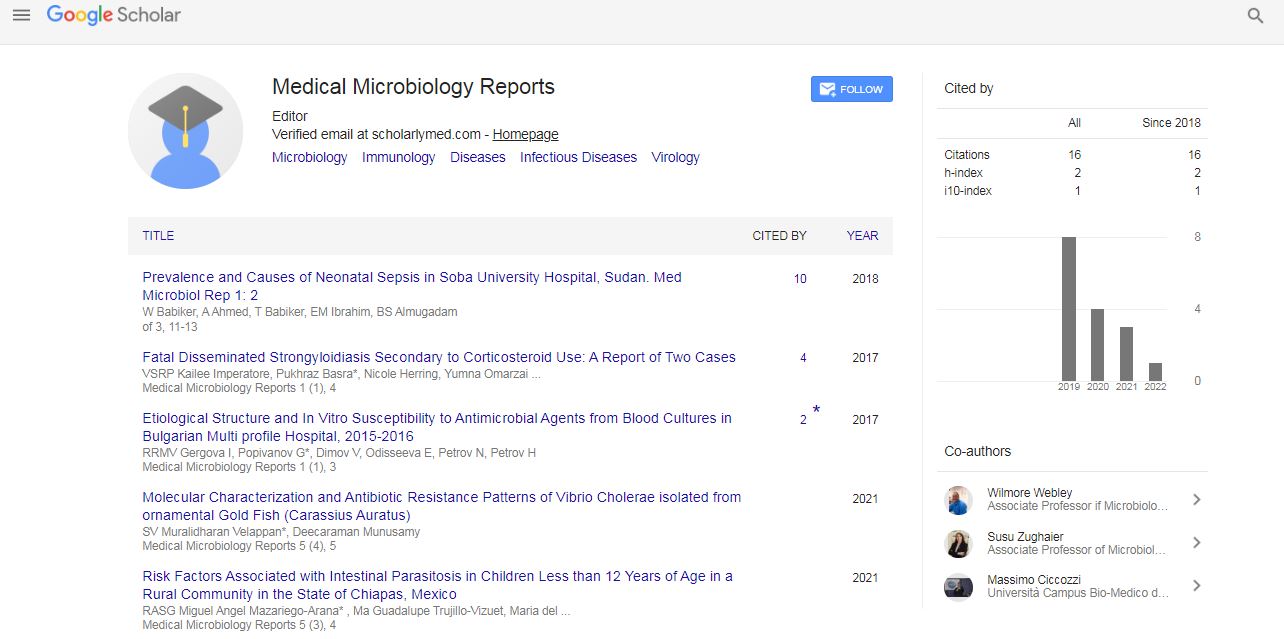Opinion Article, Med Microbiol Rep Vol: 7 Issue: 2
Significance and Evolutionary History of Virology Field
Nascimento Netto*
Department of Mycobacteriology, Pasteur University of Iran, Tehran, Iran
*Corresponding Author: Nascimento Netto
Department of Mycobacteriology, Pasteur University of Iran, Tehran, Iran
E-mail: nascimenett@gmail.com
Received date: 22 May, 2023, Manuscript No. MMR-23-107440;
Editor assigned date: 25 May, 2023, PreQC No. MMR-23-107440 (PQ);
Reviewed date: 08 June, 2023, QC No. MMR-23-107440;
Revised date: 15 June, 2023, Manuscript No. MMR-23-107440 (R);
Published date: 22 June, 2023, DOI: 10.4172/mmr.1000337
Citation: Netto N (2023) Significance and Evolutionary History of Virology Field. Med Microbiol Rep 7:2
Description
Virology is the scientific discipline that focuses on the study of viruses, microscopic infectious agents that can cause a wide range of diseases in humans, animals and plants. Viruses are unique entities that straddle the boundary between living and non-living organisms, as they possess genetic material and can replicate, but require a host cell to survive and reproduce.
The importance of virology cannot be overstated, as viruses have a profound impact on global health, agriculture and ecosystems. In humans, viruses are responsible for a myriad of diseases, ranging from the common cold and influenza to more severe conditions such as Human Immunodeficiency Virus/Acquired Immunodeficiency Syndrome (HIV/AIDS), Ebola, and Coronavirus Disease-2019 (COVID-19).
The roots of virology can be traced back to the late 19th century when analysts began investigating diseases that were suspected to be caused by invisible agents that could pass through filters designed to trap bacteria. In 1892, Dmitry Ivanovsky, a Russian botanist, conducted experiments on tobacco plants infected with what is now known as Tobacco Mosaic Virus (TMV). He discovered that the infectious agent could not be cultured on nutrient media, indicating its non-bacterial nature.
Further advancements in virology came with the work of scientists such as Martinus Beijerinck and Wendell Stanley. Beijerinck, a Dutch microbiologist, coined the term "virus" to describe the infectious agent responsible for TMV. He proposed that viruses were different from bacteria and were capable of replicating within living cells. Wendell Stanley, an American biochemist, isolated and crystallized the tobacco mosaic virus, demonstrating that it consisted primarily of protein.
The advent of electron microscopy in the mid-20th century revolutionized virology by allowing analysts to visualize viruses for the first time. The development of this technique resulted in the identification of numerous novel viruses and provided insights into their structure and replication strategies.
The field of virology expanded rapidly in the latter half of the 20th century with the development of molecular biology techniques. The discovery of the double-helix structure of Deoxyribonucleic Acid (DNA) by James Watson and Francis Crick provided a framework for understanding the genetic material of viruses. Analysts began to unravel the genomes of various viruses, shedding light on their genetic diversity, evolution and mechanisms of pathogenesis.
One significant area of virology analysis is the study of emerging and re-emerging viral diseases. Zoonotic viruses, which originate in animals and cross over to humans, have been responsible for several recent outbreaks, including the Swine Flu (H1N1) influenza pandemic in 2009 and the Ebola outbreak in West Africa in 2014. Virologists investigate the ecological factors, viral evolution and host interactions that contribute to the emergence of these diseases, helping to inform public health interventions and strategies.
Viral genomics has also become a major focus of virology analysis. High-throughput sequencing technologies have enabled rapid and cost-effective sequencing of viral genomes, facilitating the identification and characterization of new viruses. These advances have been particularly important during the COVID-19 pandemic, as analysts swiftly sequenced the genome of the novel coronavirus, Severe Acute Respiratory Syndrome Coronavirus 2 (SARS-CoV-2), allowing for the development of diagnostic tests, vaccines and antiviral therapies.
Conclusion
Virology is a captivating field that plays a vital role in understanding the viruses and their impact on human and animal health. The ongoing advancements in technology, combined with interdisciplinary approaches, have propelled the field forward, enabling people to combat viral diseases more effectively.
 Spanish
Spanish  Chinese
Chinese  Russian
Russian  German
German  French
French  Japanese
Japanese  Portuguese
Portuguese  Hindi
Hindi 
